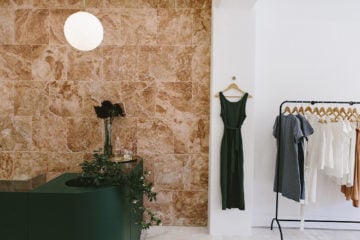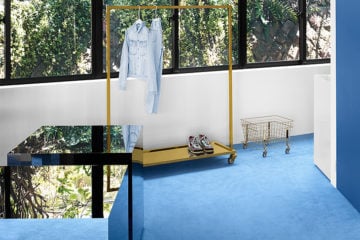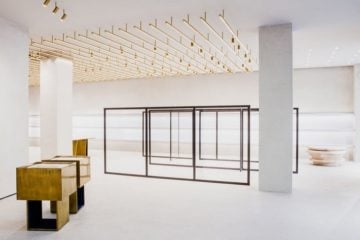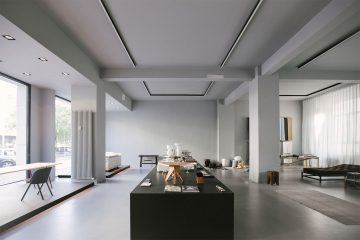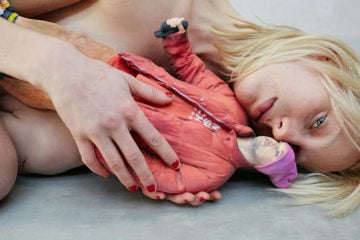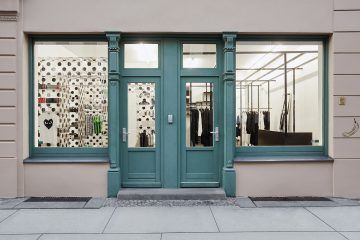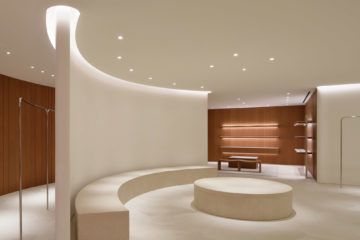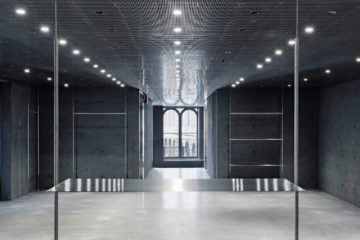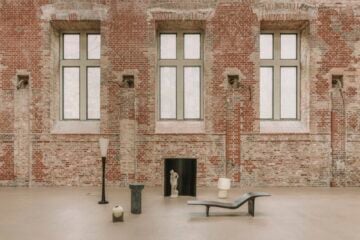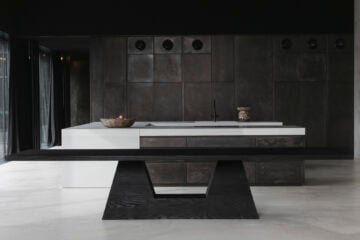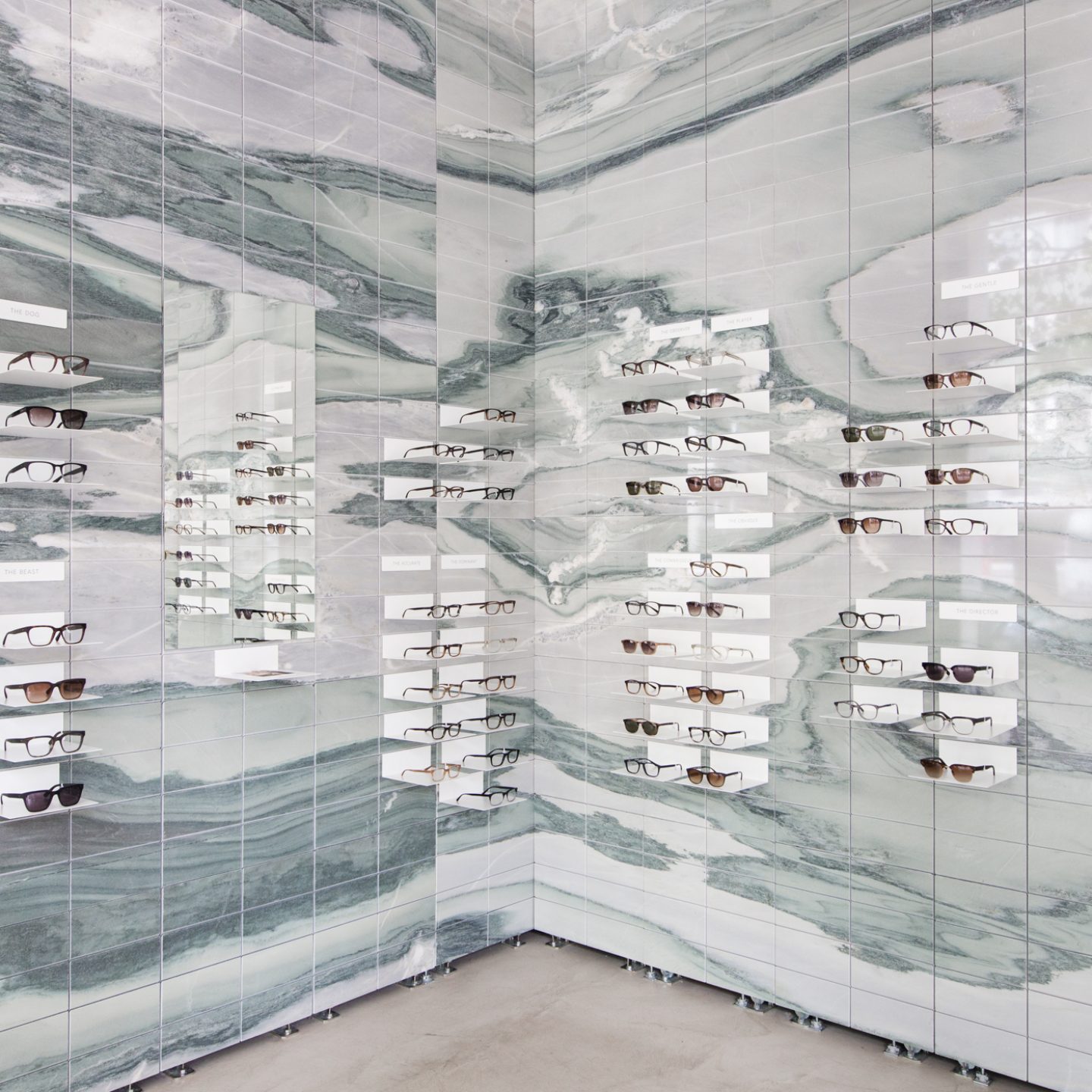
VIU Eyewear Store · Berlin, Germany
“Framing characters” reads the elegant white subtitle adorning a spacious glass store facade giving way to a marbled, mirrored interior on Berlin’s Potsdamer Straße.
The slogan belongs to VIU, one of Europe’s foremost eyewear brands that has been making its mark across Germany, Switzerland and Austria since 2013, providing locals with eyewear designed in Zurich and hand-made in Italy or Japan. Inspired by the brand’s pared-back design philosophy and focus on materiality, we dropped in to VIU’s Berlin branch to get to know Fabrice Aeberhard, co-founder and creative director about finding the essence of a product, the search for like-minded production partners, and how to choose the perfect pair of frames.
There have been many new eyewear ventures popping up across Europe in recent years. What inspired the birth of VIU, and how has it come to distinguish itself as a brand in a busy market?
“Customers should know exactly what’s behind each pair.”So at the start of 2013, five founders sat down together to start the brand, and we sought the help of an optician – who became our fifth founder – and ran through our idea. At that time it wasn’t like there were a whole bunch of other brands popping up yet. Instead, it was an opportunity for us to make an accessory accessible, also in terms of pricing, but settle for nothing less than the best possible quality of glass and frames at the same time.
It’s important to us to be able to pass on the prices in a way that reflects what they truly are. It’s crazy to think that an average pair of glasses in Switzerland costs around 600 CHF, and one in Germany costs around 370 – 380 Euro. For something that is a necessity. So we wanted to offer the best at an affordable price. One of our key values at VIU is honesty, transparency. Customers should know exactly what’s behind each pair – how they’re produced, who we work with, which materials we use, why we do things the way we do.
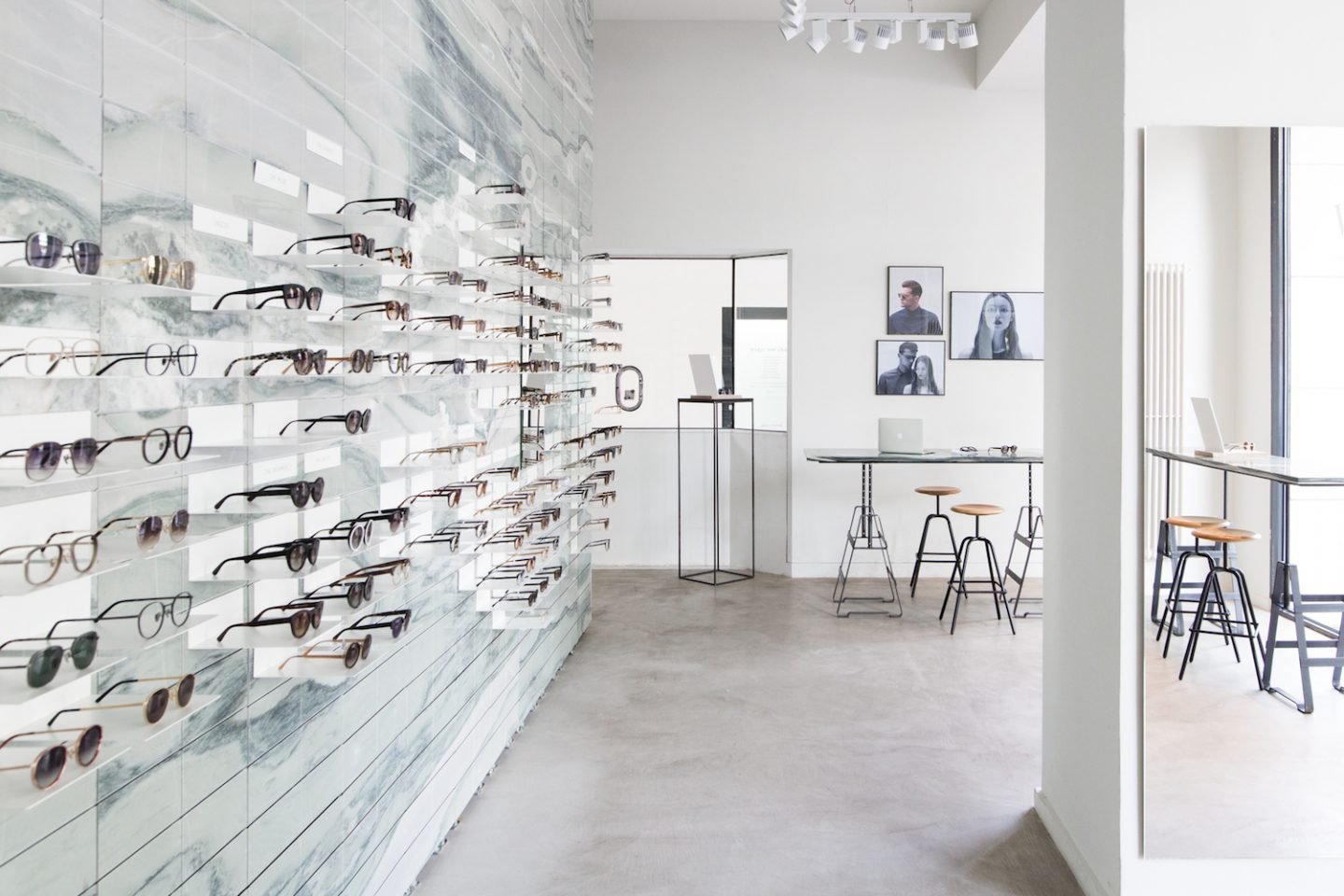
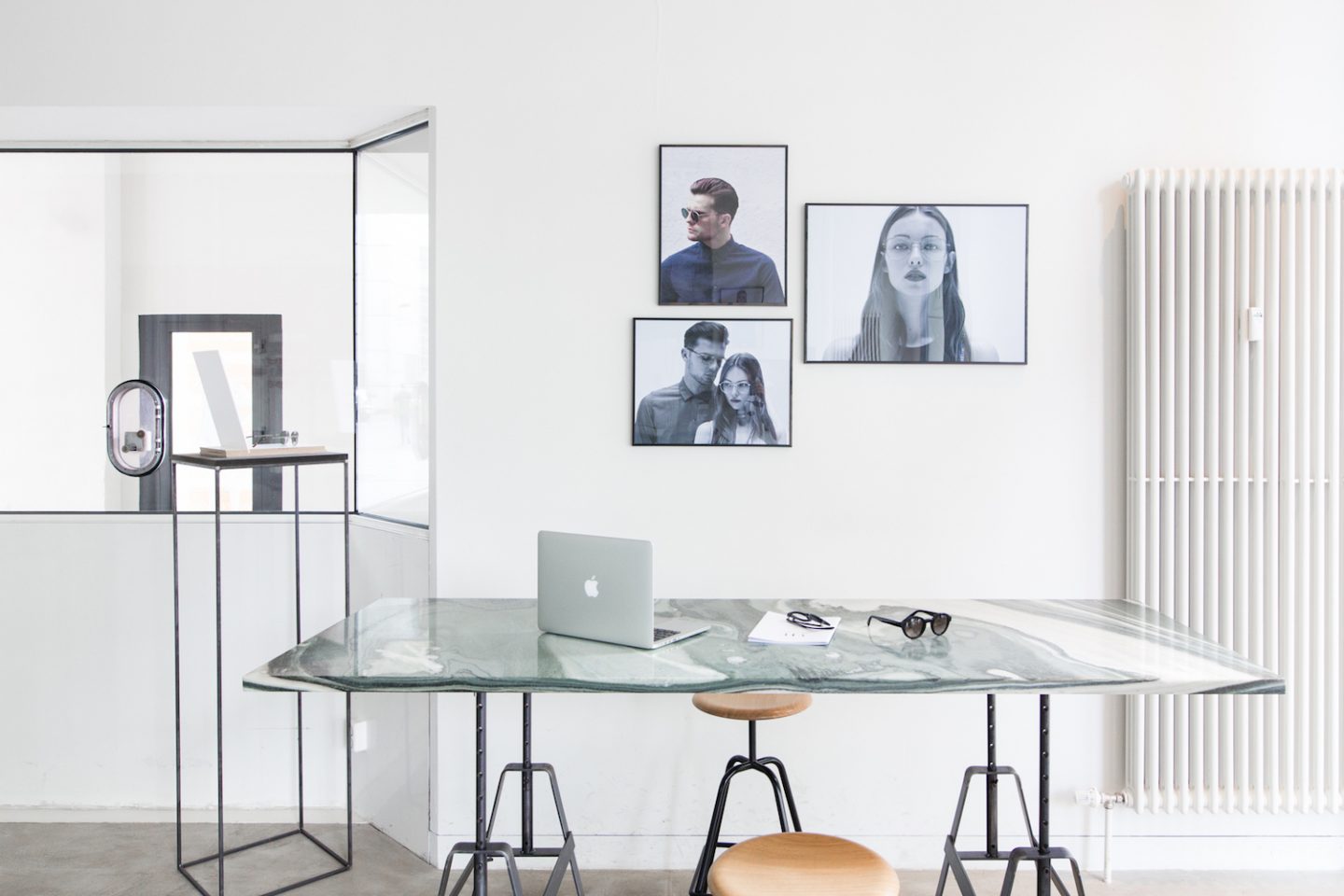
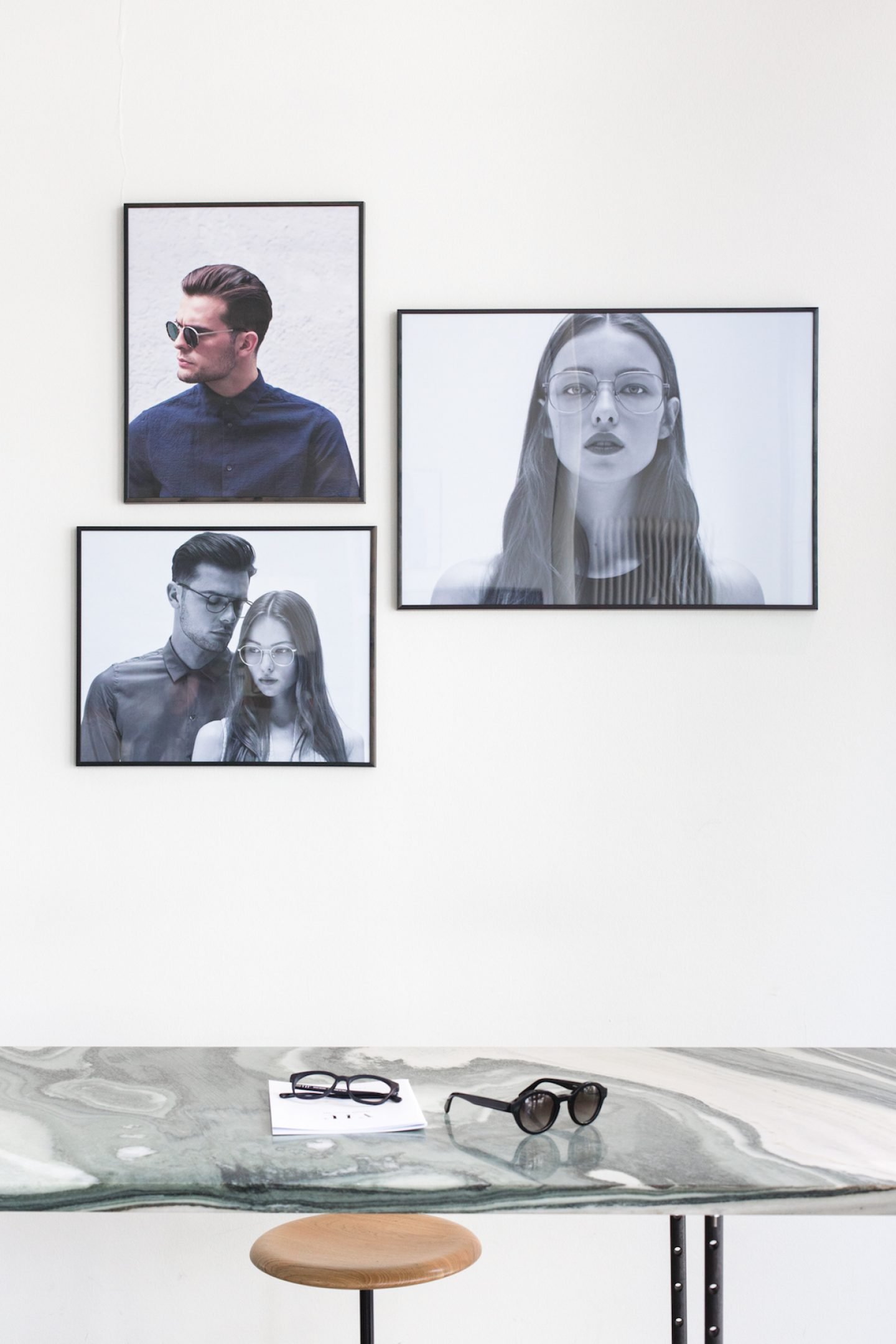
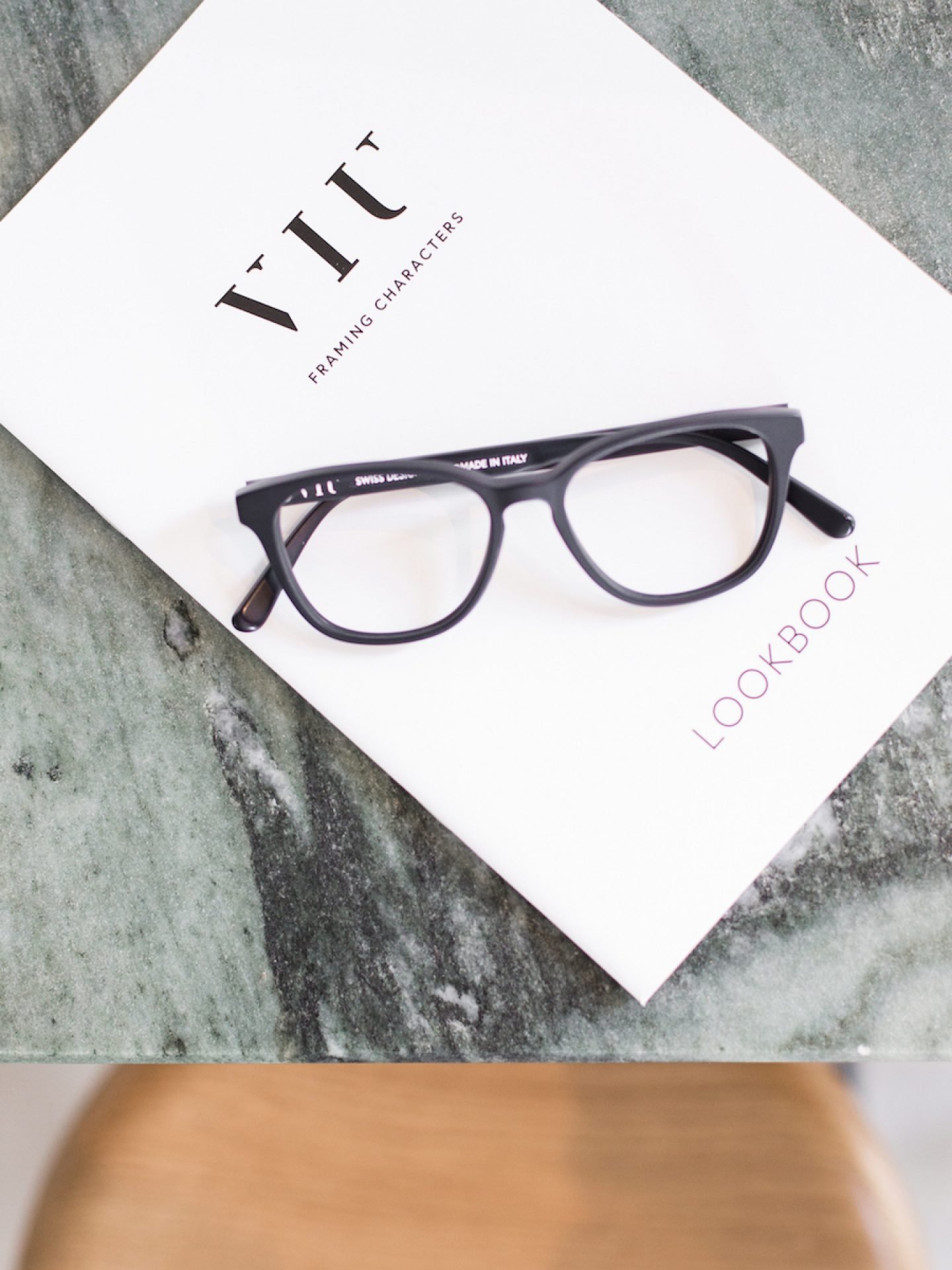
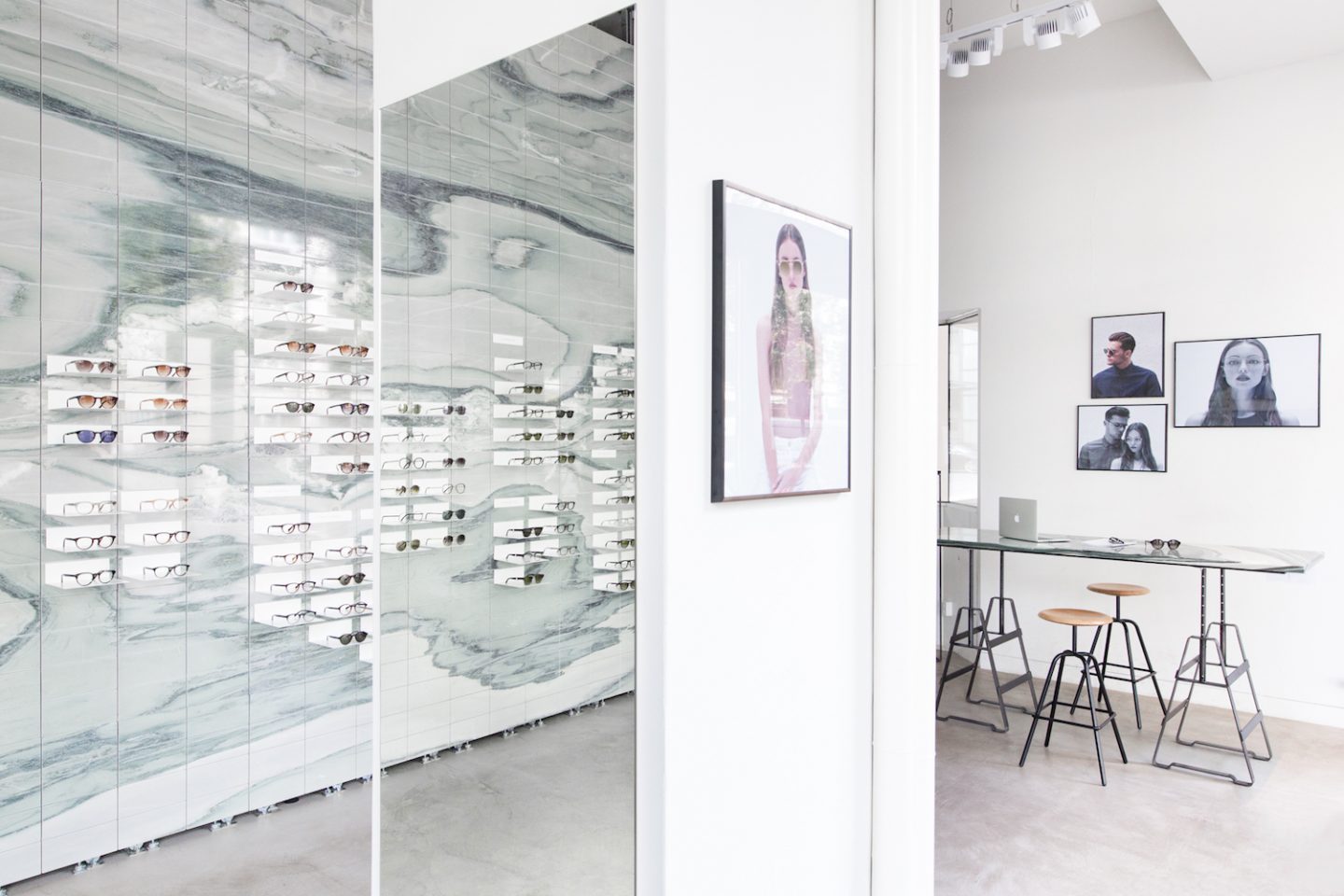
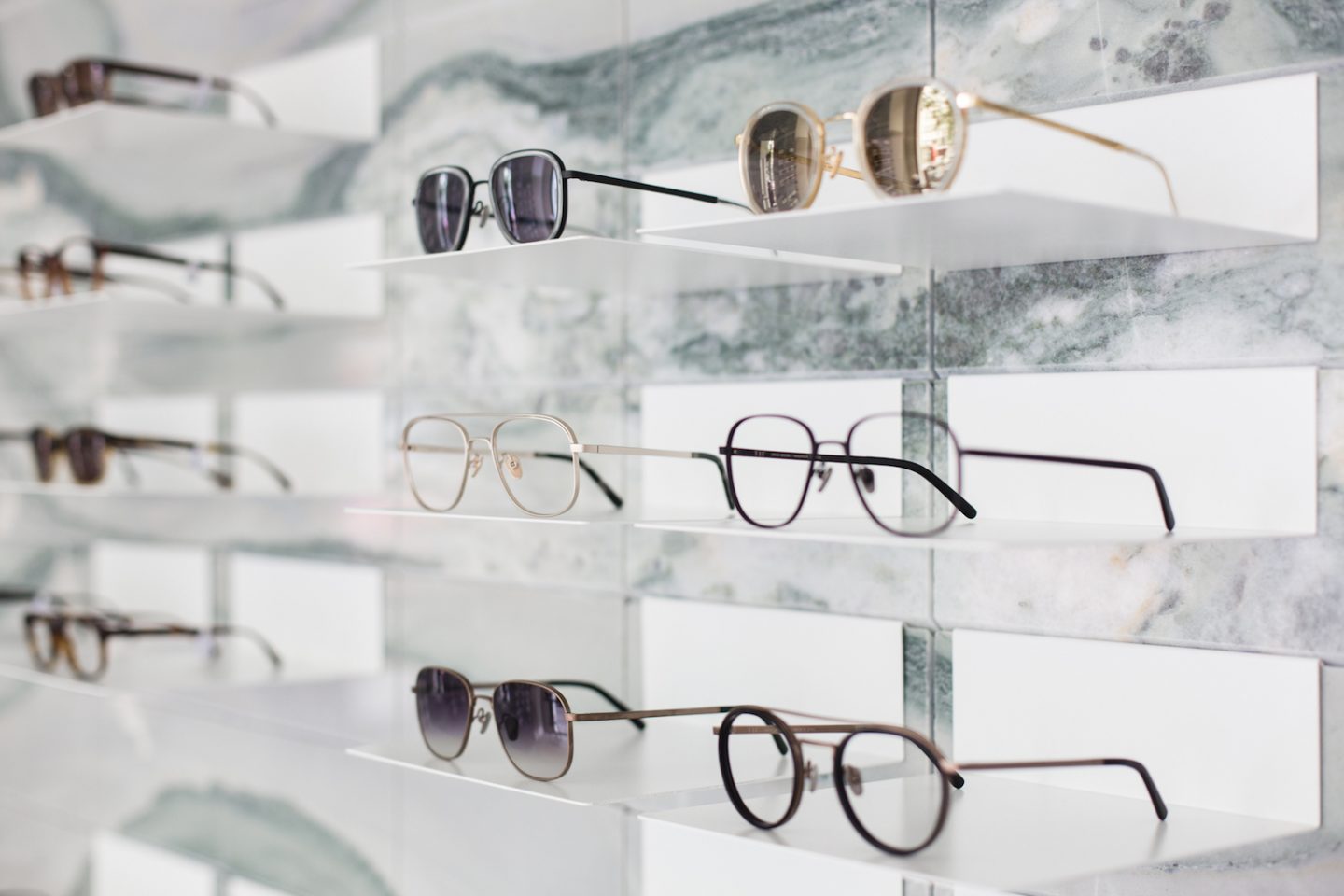
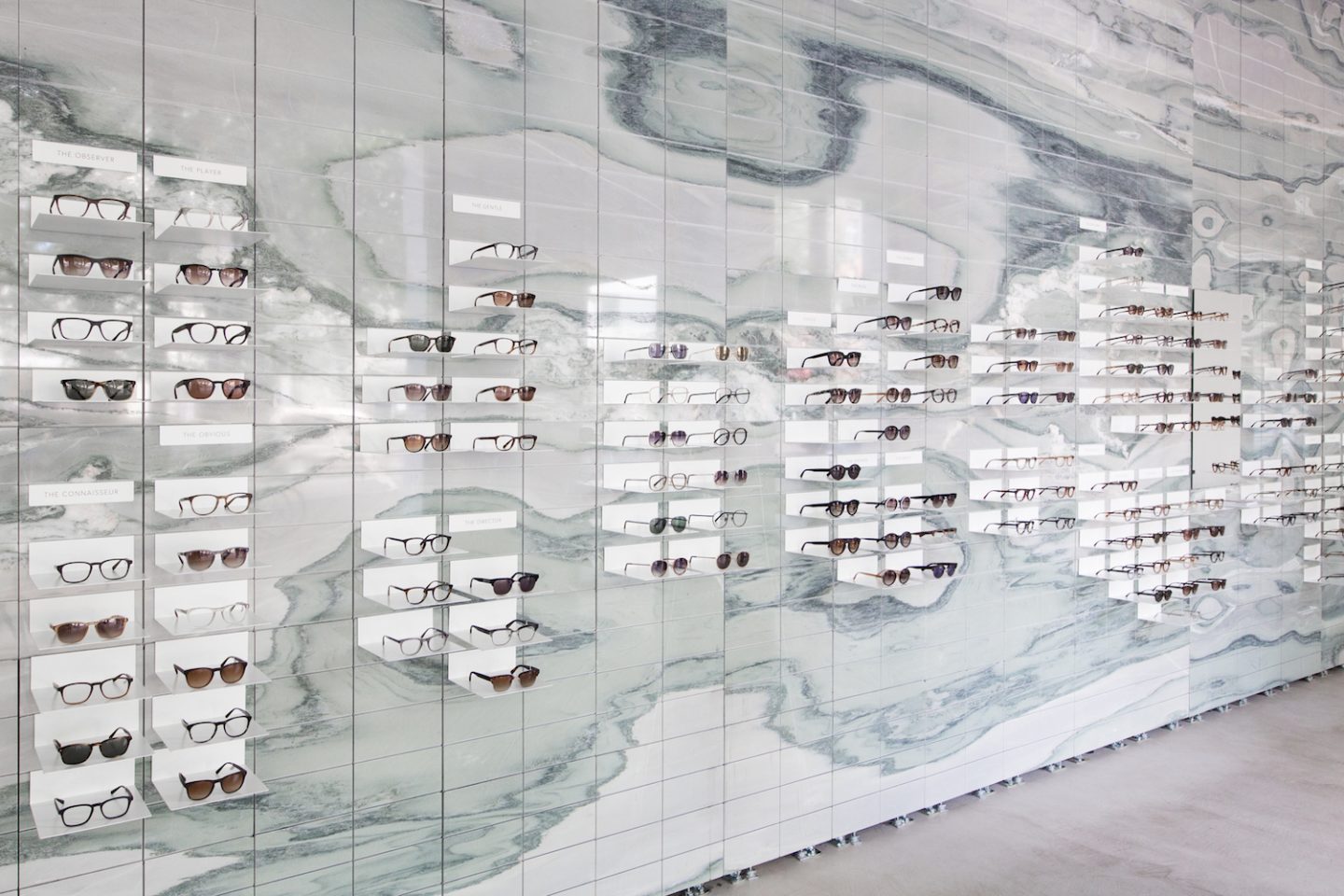
One of VIU’s five founders, your background lies in industrial design. What led you to directing the design for an eyewear brand?
So I studied industrial design till 2005, then I worked in automotive and transportation design in Munich and California for a short period of time. I didn’t find that super interesting – but eventually it lead me, together with Christian Kaegi, to found Aekae, a design agency in Zurich in 2006. We quickly started working with clients in all sectors – cafes, retail stores…This experience was invaluable for getting to grips with overall brand concepts. There’s nothing better than clients to teach you the things that weren’t conveyed at university! Around 2008, we founded the bag label Qwstion. In 2009, we opened a cafe in Zurich – that was an exciting project.
“It’s important to determine the founding principle of the brand, and for me, that’s essence.”Then in 2010, we founded the eyewear brand SIRE. It was sort of the Bentley of glasses – each pair was handmade in Switzerland. And then at the beginning of 2013 we founded VIU, which is fascinating, because I can build the whole brand world for the label. It’s important to determine the founding principle of the brand, and for me, that’s essence. Essence as in, have you only build in the essentials, and removed everything extraneous? You can always introduce extra elements later on to shape the brand’s character, but ultimately it comes down to the interplay between product and person. And the person should wear the glasses, not the other way around.
Designed in Zürich and hand-made in Italy. Can you shed some light on the relationships you have with your production partners?
One of the first steps we took back when we founded the brand was to find the right production partners. The process was a long one. We spent some time in the region of Cadore, Northern Italy, which known for its optical glass production, and visited around 25 manufacturers, but weren’t really happy with any of them. A lot of what they were working with seemed like totally standard plastic, which is a shame when you consider the potential of the material. We were there for 10 days, and on the last day, we came across a factory – at 1400 meters above ground! – and got a good feeling right from the get-go.
It’s run by an Italian family business, second generation. There’s the father, Luigino, who is 72, but still in the workshop every day, and the mother, who is an optometrist. The daughter has taken over the management of the business, which now includes 12 – 14 people, and we had a lot of fun with the team. We came into it without too much experience, but since then we account for a large part of their output. It’s a great relationship – we’re there every six to eight weeks – and they come to visit us in Zurich sometimes. It’s a beautiful story, and hopefully it will continue in this way. Production is the most important element for us, because it’s the only way to control quality.
You have 16 stores across Germany, Austria and Switzerland, each with their own distinctive interior. What are the key elements you took into account when deciding how to fit out each space?
“Production is the most important element for us, because it’s the only way to control quality.”Well, looking at our wall you can see our signature style already. The panels are cut with a C&C machine, which needs to be really precise, so that we can hang the shelves and the mirrors. It’s a very modular design that allows us to adapt it to the latest range, a shoot, a launch, whatever we need. We also have these tables – although we had to make a bit of an exception in the Berlin store – but the table tops are all the same thickness – usually 12 x 24 cm, so 2:1, and then everything else in store is something of a reflection of this wall, in terms of the ratio or size. We also have the same table and stool legs in each space. Back to the feature wall, In Vienna we played with something new and used used galvanised aluminium, which is a really exciting material.
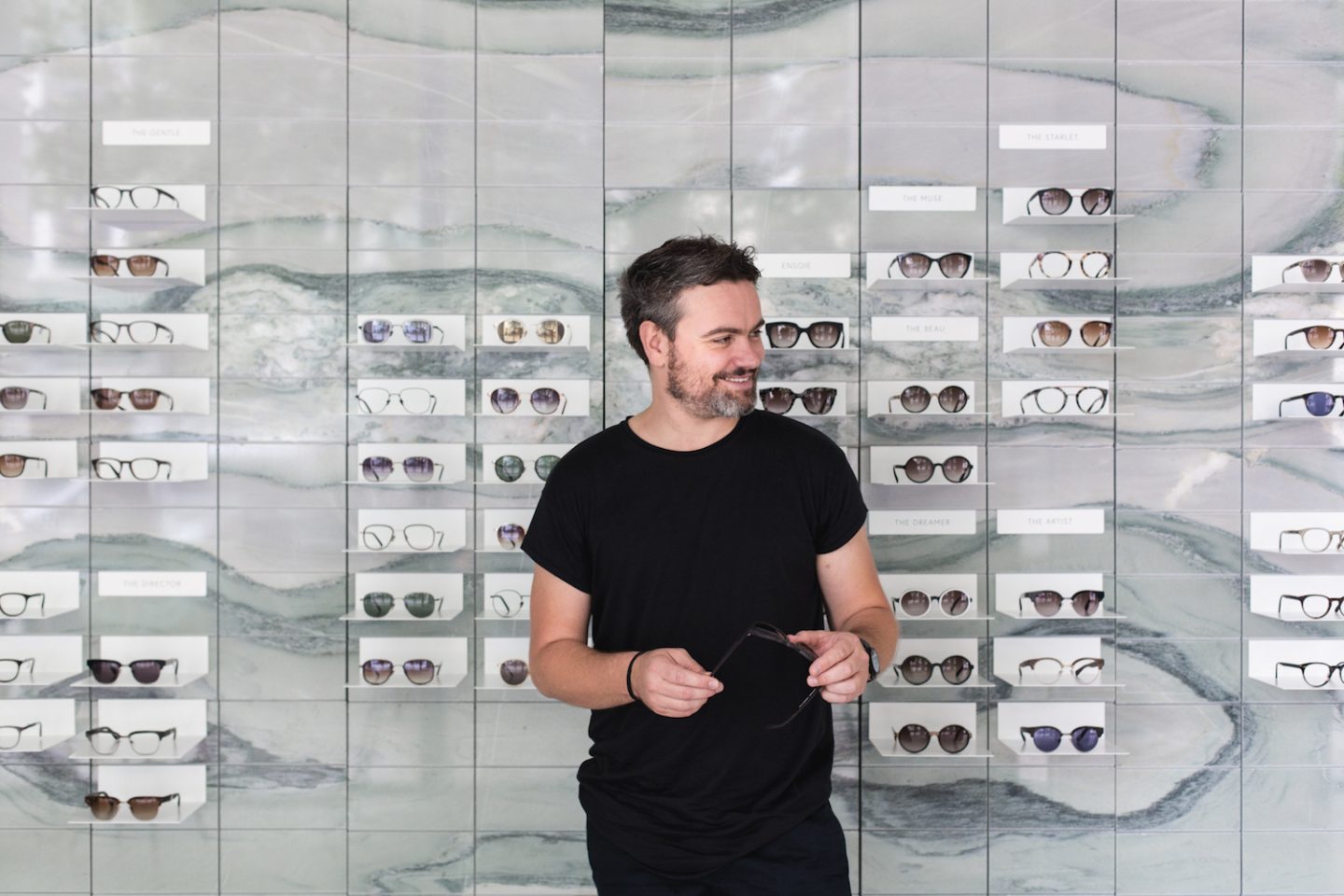
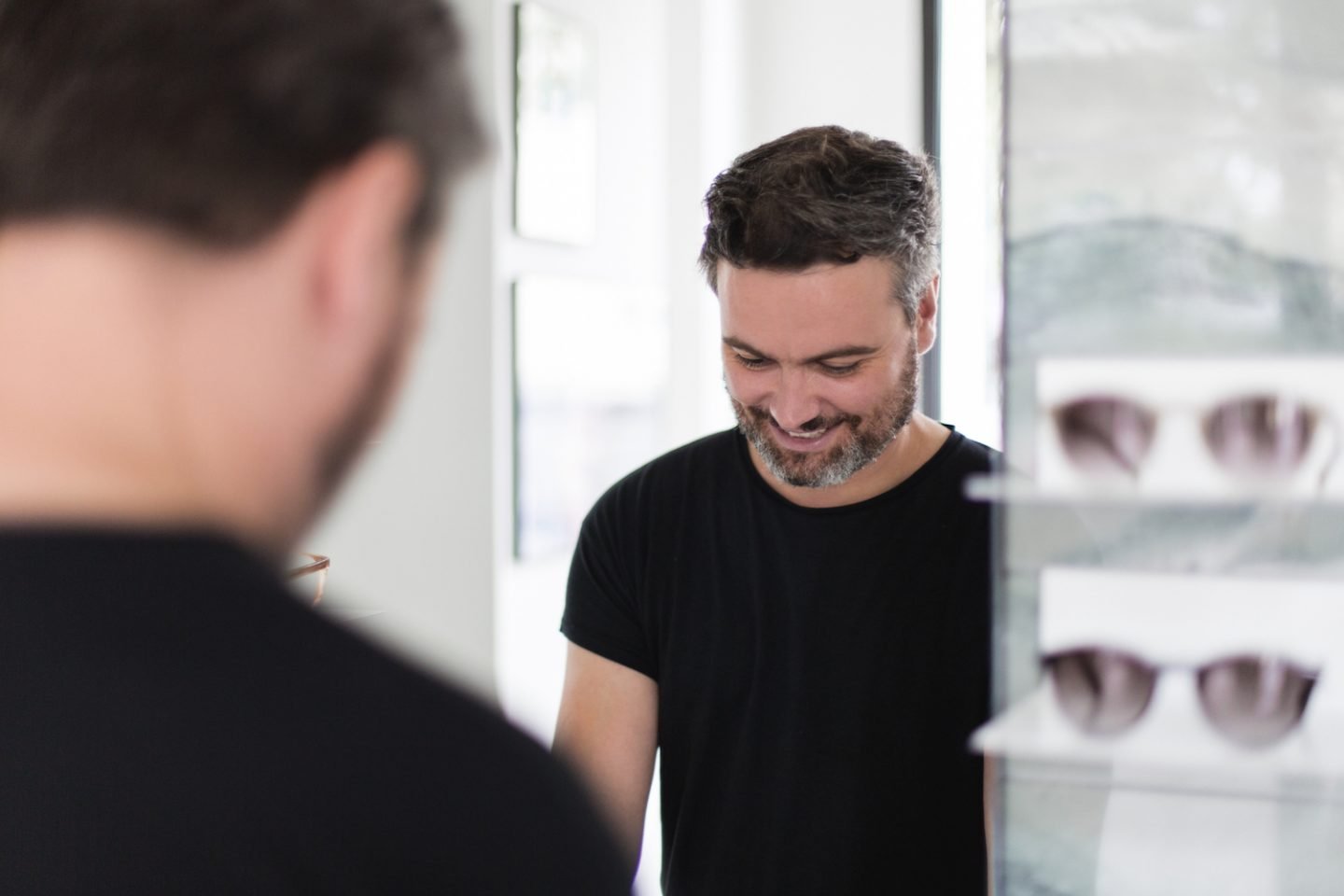
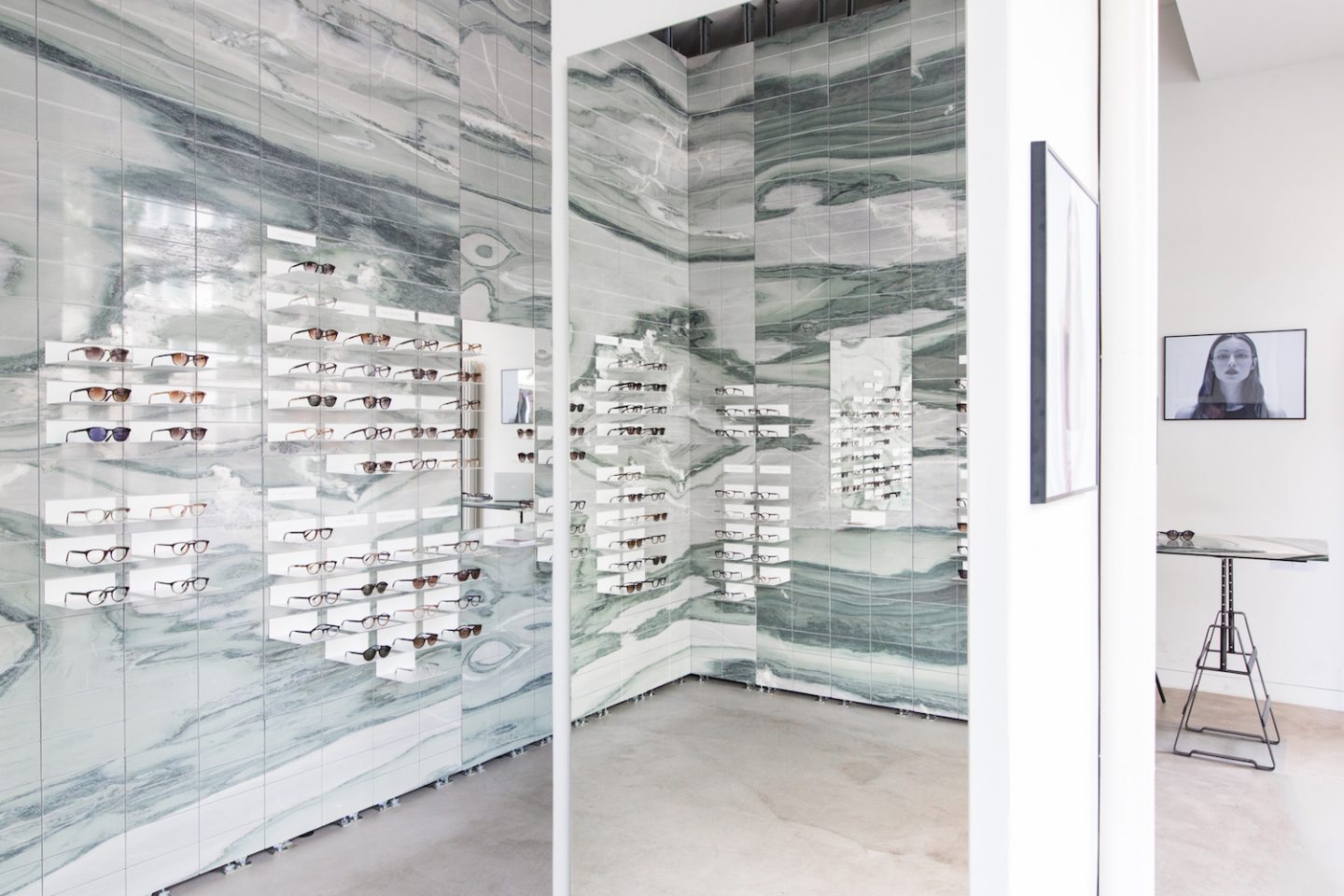
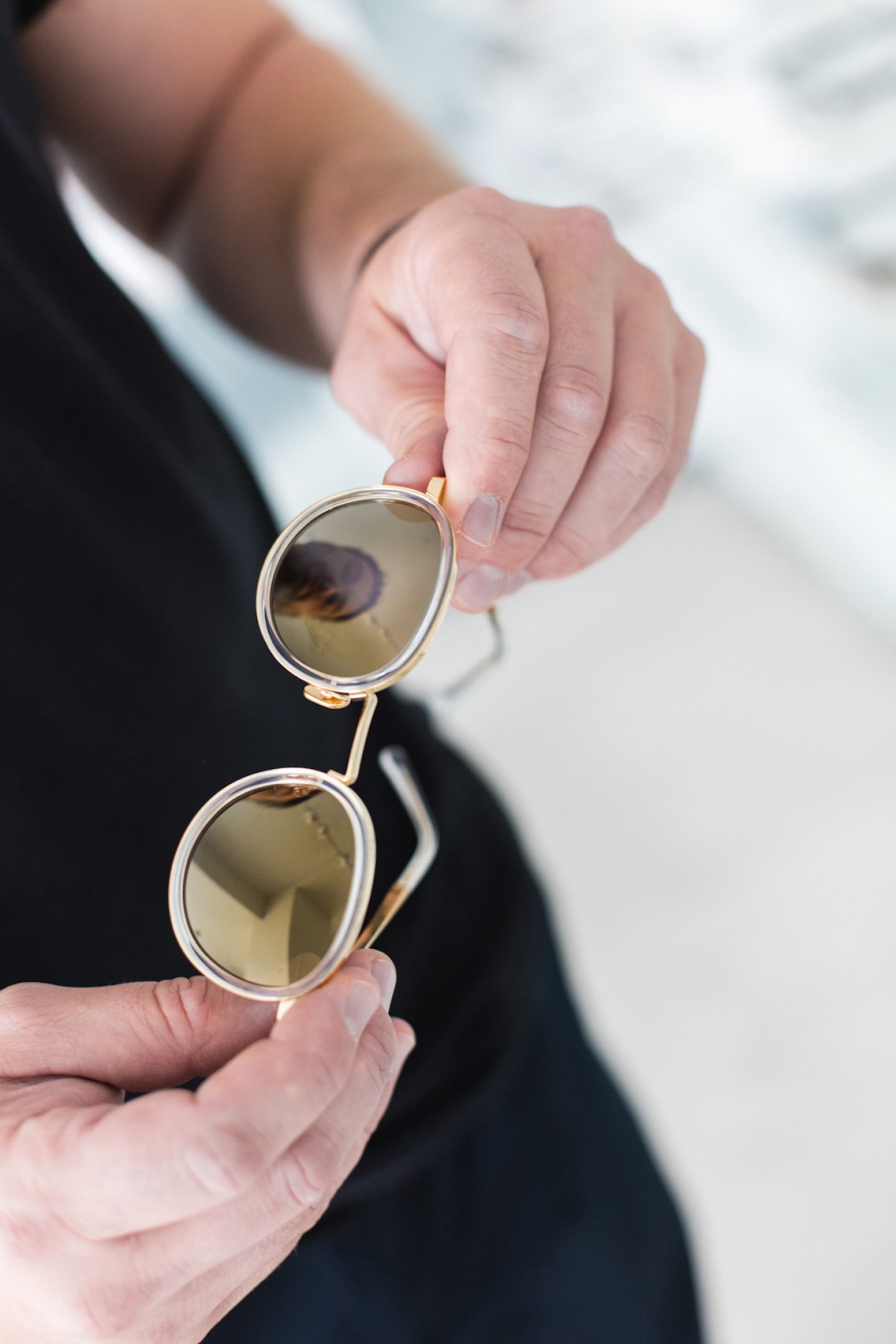
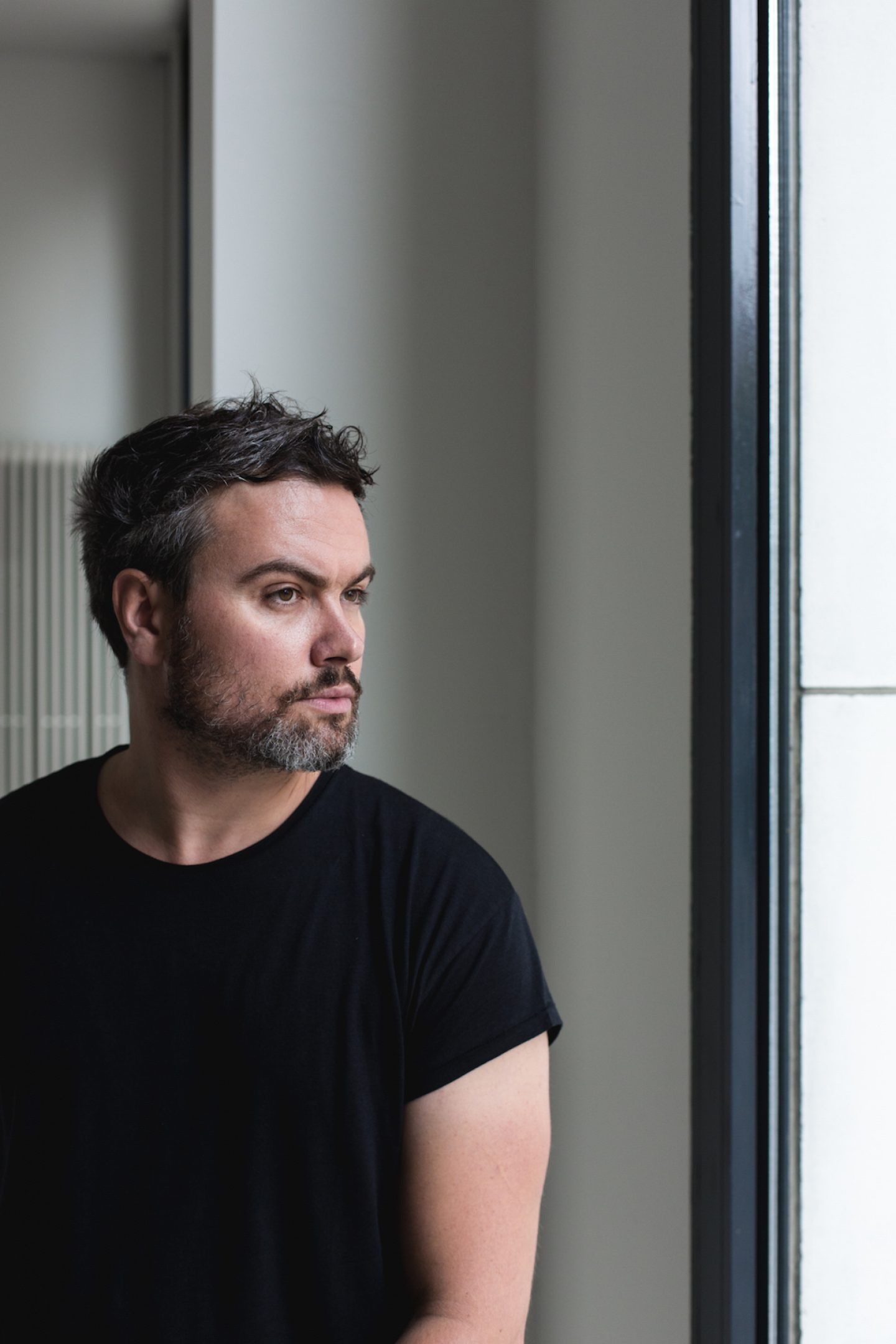
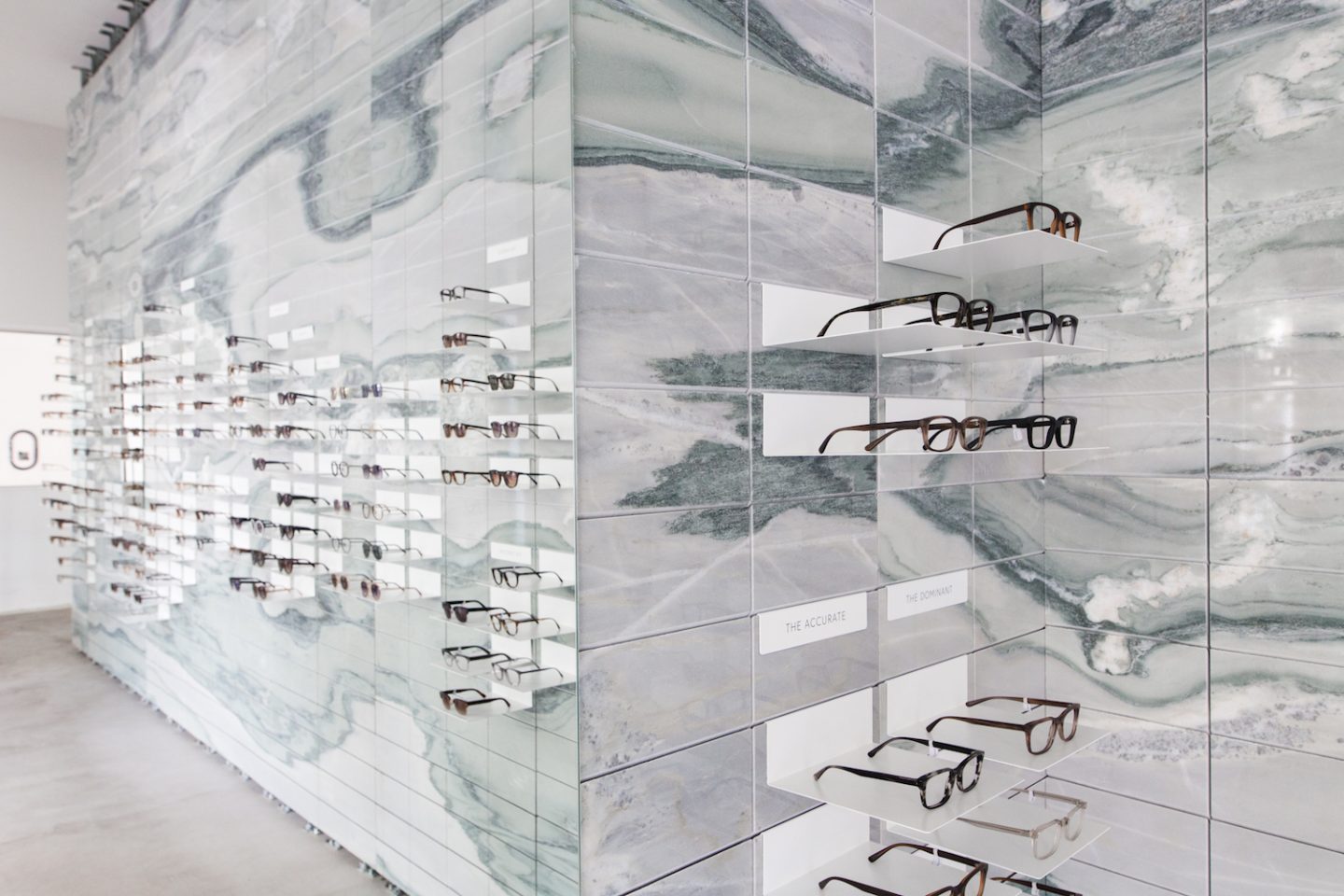
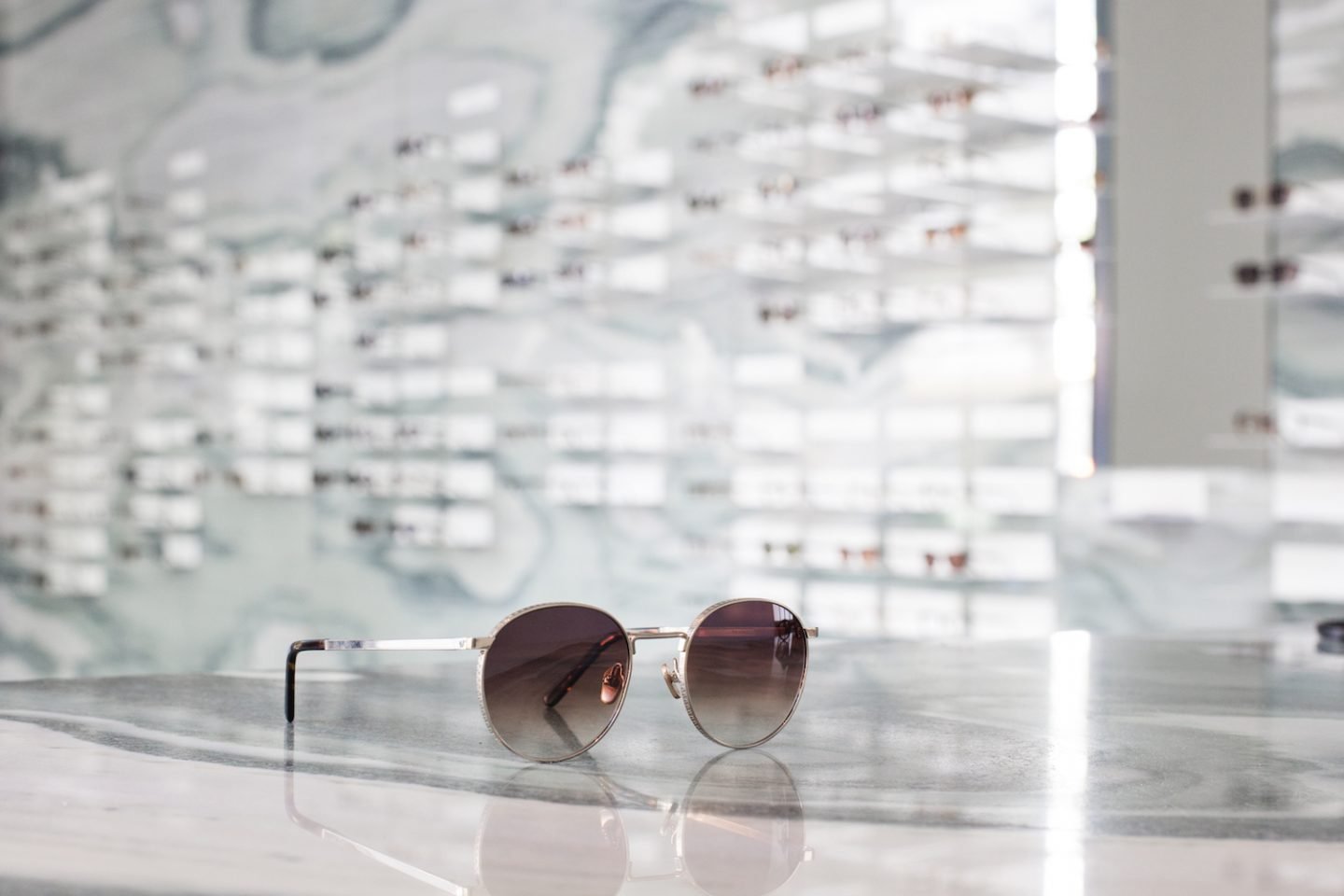
What role does design play in establishing the kind of experience you hope to offer your customers when they enter the store?
For us, design plays a hugely important role in the company. We’re an omni-channel system: You can find us online, order try-at-home, find our frames in our partner stores or visit our flagship store. And the latter is the only place where we can really present VIU as VIU. We want people to talk about us, and come by to different stores in different cities, see how we reinterpret different elements between the cities and the stores. One brand that I really admire and hold up as a great example is Aesop. They’re always on point – and they have over 150 stores worldwide now – but they’ve managed to grow the company in such a careful and consistent manner. To take the time you need to grow properly, that’s crucial, I think.
Materials play a leading role in the VIU concept: both in your stores and in terms of the glasses themselves. What’s the VIU philosophy on materiality?
“We should always know what we’re using, and the specific function we’re trying to fulfil.”One of the most important things is the integrity of the material. We should always know what we’re using, and the specific function we’re trying to fulfil. For example, the marble we’re using here for the feature wall wasn’t necessarily intended to be deployed in this way, because stone is really breakable. So we’re going in the direction of concrete here, meaning we end up with something very hard, and of course that can also keep things interesting, as you’ve got to watch out for potential issues – but here we’ve used four tonnes of stone, which is crazy when you think about what it took to transport, adapt and install it.
For example, these small feet are holding up the wall, and carrying so much weight. In terms of materiality and glasses, we seek out materials that can withstand a lot of pressure – and are of course the best quality we can find. So we use acetate from Italian, which – depending on the color – contains 70 – 93 % cotton, making the frames super flexible [picks up a pair of frames and bends them]. We’re creating products that you practically can’t destroy.
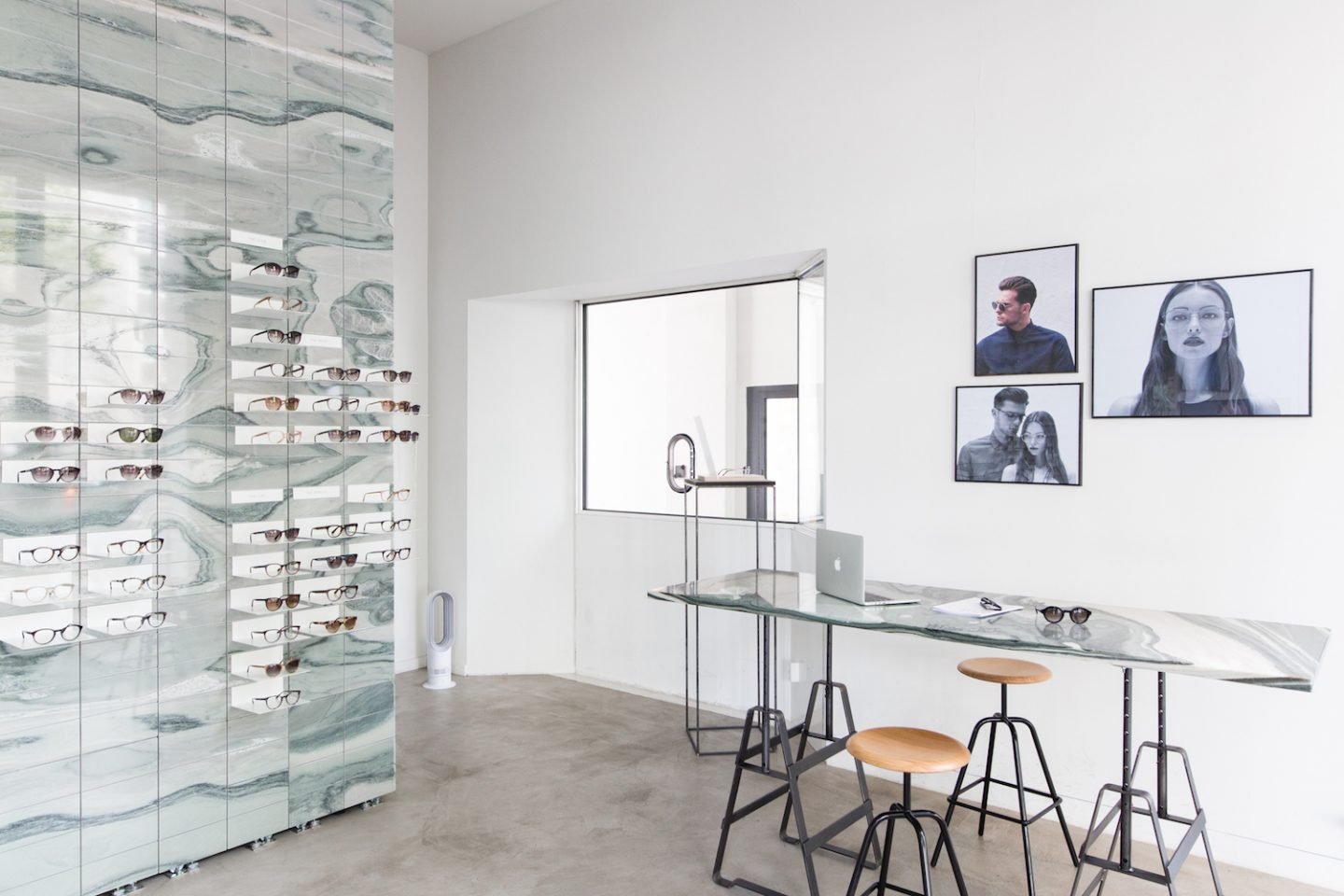
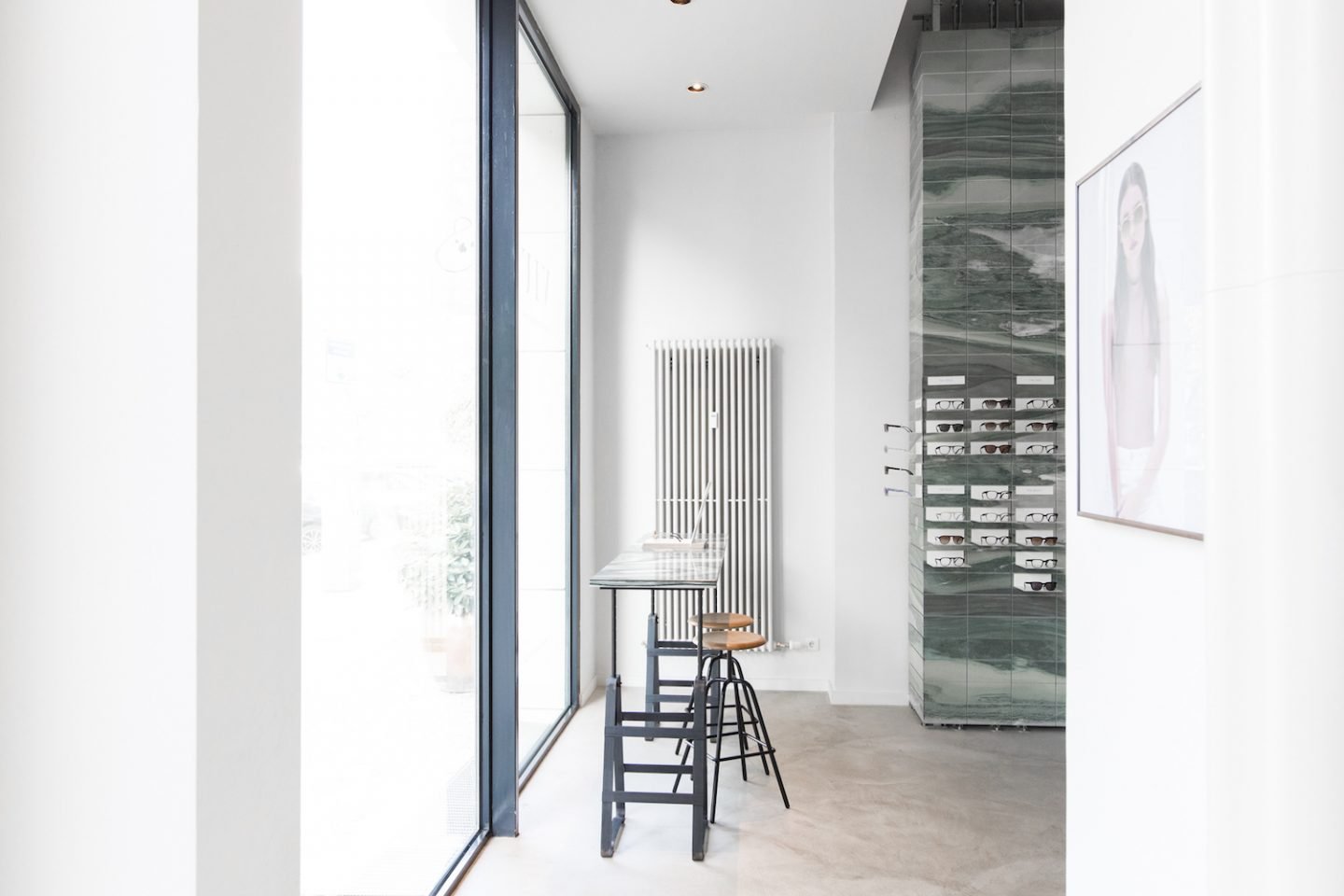
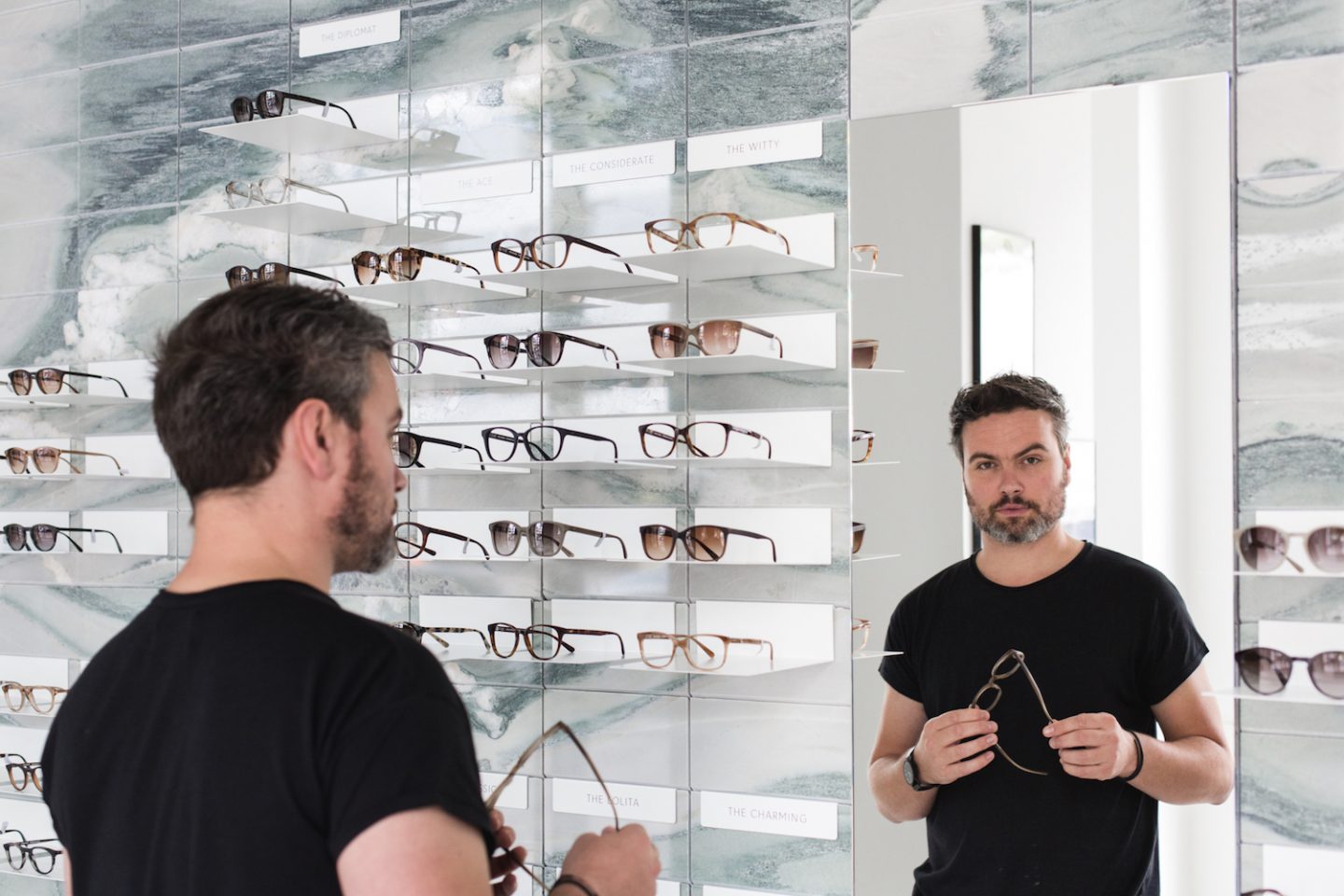
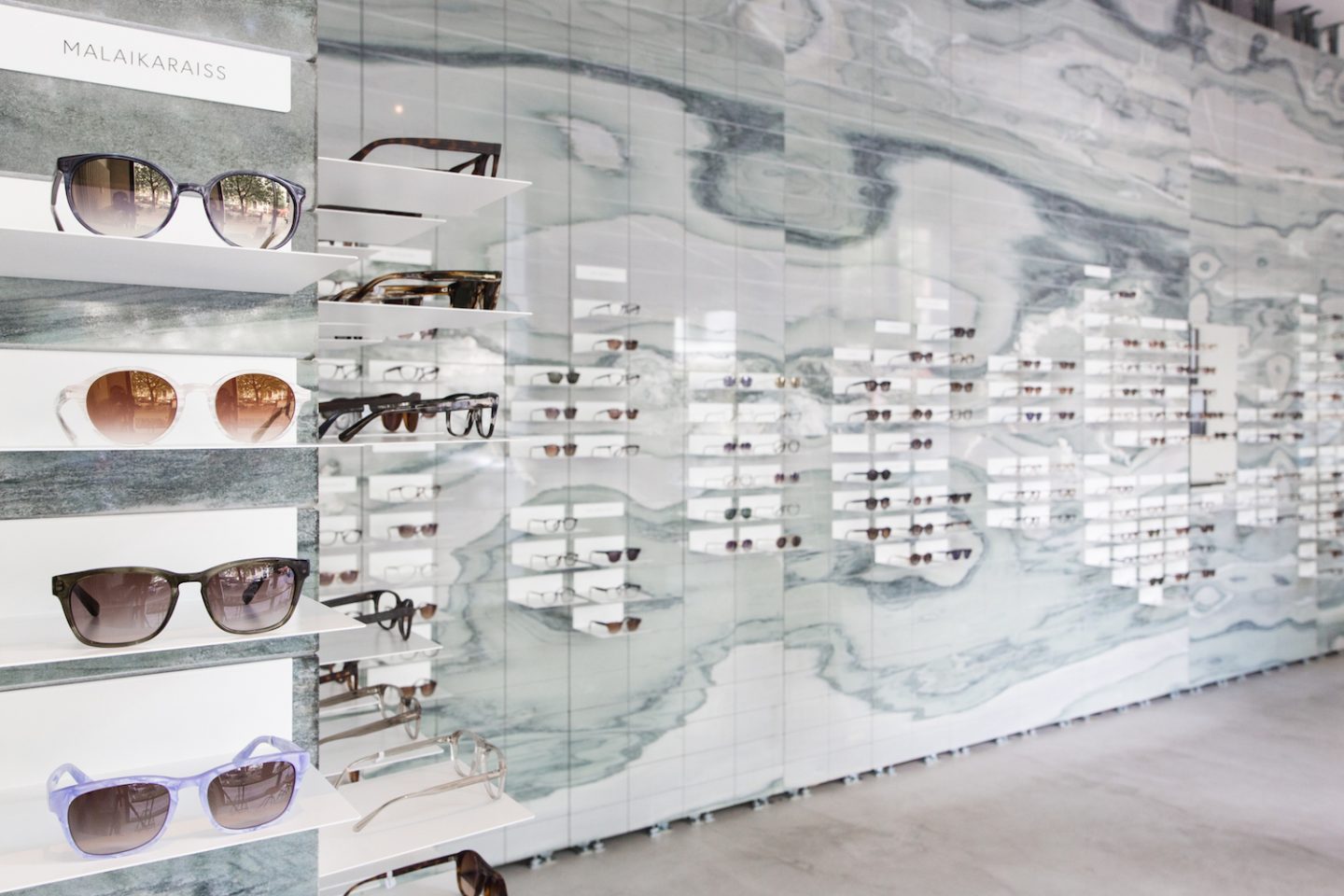
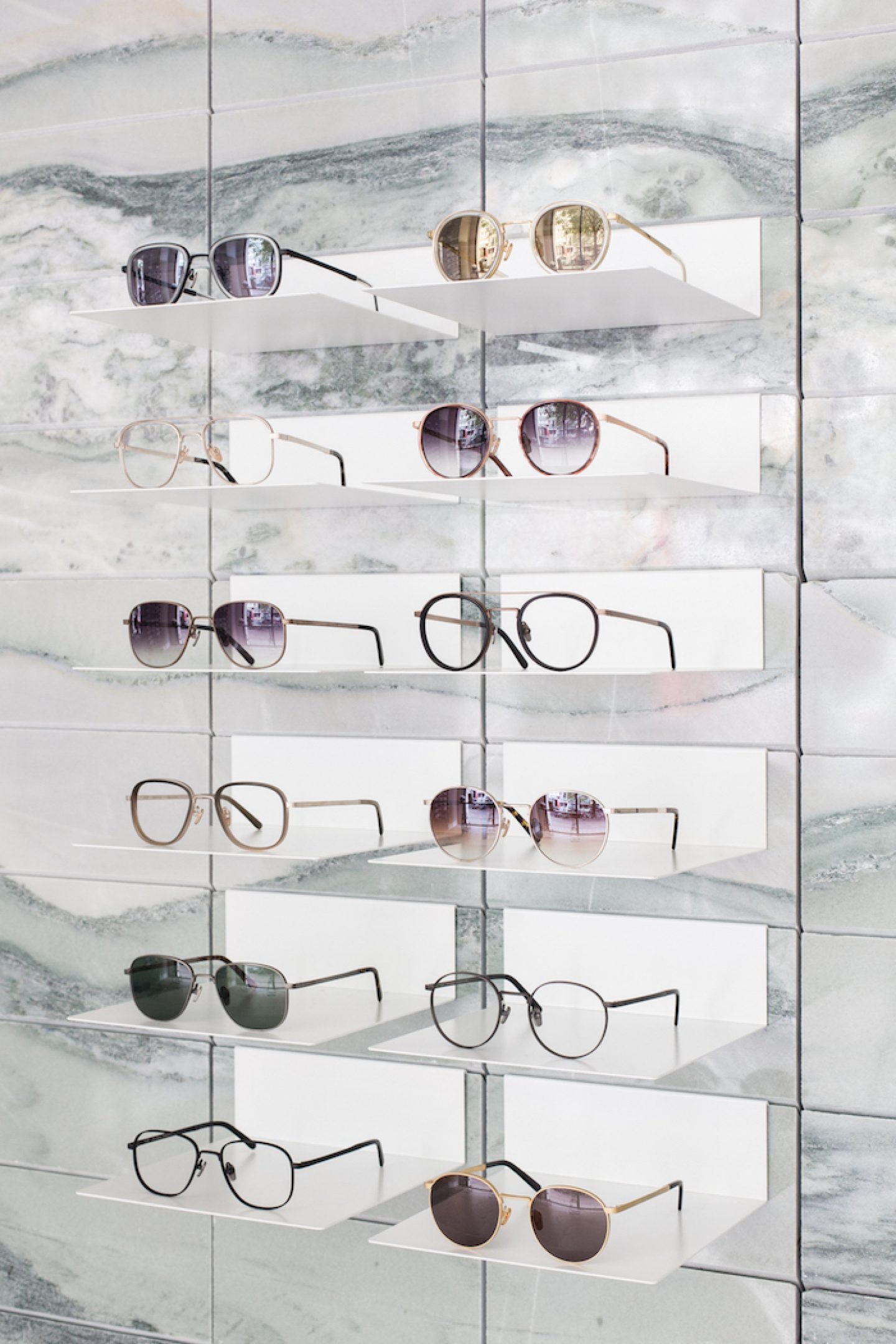
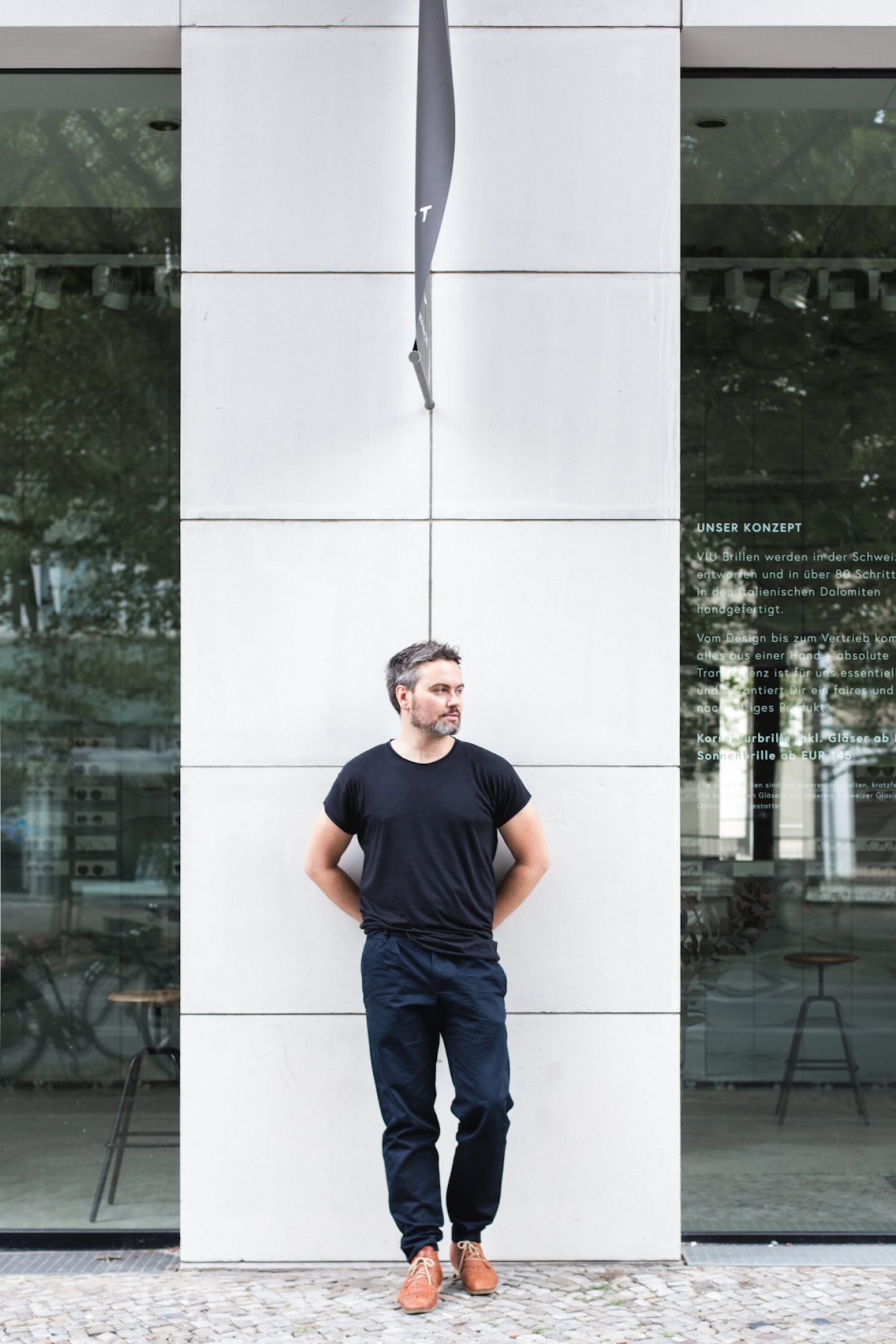
VIU has undertaken many collaborations, including with jewellery designer Saskia Diez, the model Patricia Schmid and silk brand Maison enSoie. What’s the key to successful creative collaborations, and how do you go about choosing the people and brands you partner with?
“Collaborations allow us a bit of room to play with our usual character, to edge away from our DNA.”Being like-minded in terms of priorities: Quality, origin of materials, and design aesthetic. For example, with Saskia Diez this worked really well. Saskia is a well-known jewellery designer from Munich, who works a lot with geometric forms, so we were on the same page from the get go. The product we created was’t yet in our range. And that’s the beautiful thing with collaborations: You both share your skills, and eventually create something totally new, or other.
Collaborations allow us a bit of room to play with our usual character, to edge away from our DNA and experiment a bit, go a little crazy. [Picks up frames.] What we have here is this perfect combination of her strength: jewellery, and our sunglasses, which are all made from nylon. So it’s essentially like one lens. Nylon is really stable, and we’ve turned it into the entire pair of glasses. It’s a very nice product – you can have fun with the chains, wear them however you want. They’re fun – you can play.
Your ‘Titan’ collection, launched this year, offers a range of elegant styles handmade in Japan. What was the inspiration behind this range, and what does the ‘made in Japan’ label represent?
“For the Titan range, the frames are super stripped back – only the essentials remain.”With the Titan range, we chose to source from Japan as they’re the best titanium producers in the world, and also have the longest heritage working with the material. We built in a few elements that make the range distinctly VIU – there’s a fineness in the front, and a depth to the sides. It was important to us to incorporate these things that distinguish us as a brand. We only use pure titanium, so the strongest, lightest type of titanium there is.
With our production processes we always try to incorporate the location of production into the designs, to find the essence again. So for the Titan range, the frames are super stripped back – only the essentials remain. There are tiny add-ons for some frames: for example, this all-over embossing at the top, created with the repetition of a V shape. But you don’t have to be able to see it – it’s simply there to create a structure. As for color, we’re not into super bright tones. We like to keep things earthy, pastel-based.
What advice do you give your customers to help them choose the perfect pair of frames for their face?
It always comes back down to the interplay between the product and the character of the wearer. Many glasses wearers try to hide themselves behind their frames, but actually I think the goal should be to find the perfect balance between frames and character. That’s all there is to it. I mean, glasses sit in the middle of the face. They’re inherently a statement.
"I think the goal should be to find the perfect balance between frames and character."
All images © Clemens Poloczek, created exclusively for iGNANT. Interview by Anna Dorothea Ker.
